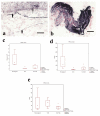Influence of pregnancy and labor on the occurrence of nerve fibers expressing the capsaicin receptor TRPV1 in human corpus and cervix uteri
- PMID: 18267041
- PMCID: PMC2254422
- DOI: 10.1186/1477-7827-6-8
Influence of pregnancy and labor on the occurrence of nerve fibers expressing the capsaicin receptor TRPV1 in human corpus and cervix uteri
Abstract
Background: Cervical ripening is a prerequisite for a normal obstetrical outcome. This process, including labor, is a painful event that shares features with inflammatory reactions where peripheral nociceptive pathways are involved. The capsaicin and heat receptor TRPV1 is a key molecule in sensory nerves involved in peripheral nociception, but little is known regarding its role in the pregnant uterus. Therefore, the aim of this study was to investigate human corpus and cervix uteri during pregnancy and labor and non-pregnant controls for the presence of TRPV1.
Methods: We have investigated human uterine corpus and cervix biopsies at term pregnancy and parturition. Biopsies were taken from the upper edge of the hysterotomy during caesarean section at term (n = 8), in labor (n = 8) and from the corresponding area in the non-pregnant uterus after hysterectomy (n = 8). Cervical biopsies were obtained transvaginally from the anterior cervical lip. Serial frozen sections were examined immunohistochemically using specific antibodies to TRPV1 and nerve markers (neurofilaments/peripherin).
Results: In cervix uteri, TRPV1-immunoreactive fibers were scattered throughout the stroma and around blood vessels, and appeared more frequent in the sub-epithelium. Counts of TRPV1-immunoreactive nerve fibers were not significantly different between the three groups. In contrast, few TRPV1-immunoreactive fibers were found in nerve fascicles in the non-pregnant corpus, and none in the pregnant corpus.
Conclusion: In this study, TRPV1 innervation in human uterus during pregnancy and labor is shown for the first time. During pregnancy and labor there was an almost complete disappearance of TRPV1 positive nerve fibers in the corpus. However, cervical innervation remained throughout pregnancy and labor. The difference in TRPV1 innervation between the corpus and the cervix is thus very marked. Our data suggest that TRPV1 may be involved in pain mechanisms associated with cervical ripening and labor. Furthermore, these data support the concept that cervix uteri may be the major site from which labor pain emanates. Our findings also support the possibility of developing alternative approaches to treat labor pain.
Figures


Similar articles
-
Unaltered innervation of the human cervix uteri in contrast to the corpus during pregnancy and labor as revealed by PGP 9.5 immunohistochemistry.Eur J Obstet Gynecol Reprod Biol. 2006 Mar 1;125(1):66-71. doi: 10.1016/j.ejogrb.2005.07.020. Epub 2005 Sep 26. Eur J Obstet Gynecol Reprod Biol. 2006. PMID: 16188372
-
Changes in uterine innervation in pregnancy and during labour.Curr Opin Anaesthesiol. 2010 Jun;23(3):300-3. doi: 10.1097/ACO.0b013e328337c881. Curr Opin Anaesthesiol. 2010. PMID: 20216064 Review.
-
Presence of sensory nerve corpuscles in the human corpus and cervix uteri during pregnancy and labor as revealed by immunohistochemistry.Reprod Biol Endocrinol. 2006 Aug 29;4:45. doi: 10.1186/1477-7827-4-45. Reprod Biol Endocrinol. 2006. PMID: 16938139 Free PMC article.
-
Immunohistochemical evidence for preserved innervation of the human cervix during pregnancy.Gynecol Obstet Invest. 1987;24(2):73-9. doi: 10.1159/000298782. Gynecol Obstet Invest. 1987. PMID: 3653786
-
[Gastrointestinal Spice Sensors and Their Functions].Yakugaku Zasshi. 2018;138(8):1003-1009. doi: 10.1248/yakushi.17-00048-1. Yakugaku Zasshi. 2018. PMID: 30068839 Review. Japanese.
Cited by
-
Prolonged Dystocic Labor in Neuraxial Analgesia and the Role of Enkephalin Neurotransmitters: An Experimental Study.Int J Mol Sci. 2023 Feb 13;24(4):3767. doi: 10.3390/ijms24043767. Int J Mol Sci. 2023. PMID: 36835178 Free PMC article.
-
(Endo)Cannabinoids and Gynaecological Cancers.Cancers (Basel). 2020 Dec 25;13(1):37. doi: 10.3390/cancers13010037. Cancers (Basel). 2020. PMID: 33375539 Free PMC article. Review.
-
β2-adrenergic receptor genotype and other variables that contribute to labor pain and progress.Anesthesiology. 2011 Apr;114(4):927-39. doi: 10.1097/ALN.0b013e318211004e. Anesthesiology. 2011. PMID: 21394004 Free PMC article.
-
Capsaicin, Nociception and Pain.Molecules. 2016 Jun 18;21(6):797. doi: 10.3390/molecules21060797. Molecules. 2016. PMID: 27322240 Free PMC article. Review.
-
Excitatory and inhibitory urinary bladder reflexes induced by stimulation of cervicovaginal capsaicin-sensitive sensory fibers in rats.Naunyn Schmiedebergs Arch Pharmacol. 2009 Feb;379(2):107-14. doi: 10.1007/s00210-008-0357-9. Epub 2008 Oct 7. Naunyn Schmiedebergs Arch Pharmacol. 2009. PMID: 18839149
References
-
- Anim-Somuah M, Smyth R, Howell C. Epidural versus non-epidural or no analgesia in labour. Cochrane Database Syst Rev. 2005:CD000331. - PubMed
-
- Ekman G, Malmstrom A, Uldbjerg N, Ulmsten U. Cervical collagen: an important regulator of cervical function in term labor. Obstet Gynecol. 1986;67:633–636. - PubMed
-
- Granstrom L, Ekman G, Ulmsten U, Malmstrom A. Changes in the connective tissue of corpus and cervix uteri during ripening and labour in term pregnancy. Br J Obstet Gynaecol. 1989;96:1198–1202. - PubMed
-
- Schwalm H, Dubrauszky V. The structure of the musculature of the human uterus--muscles and connective tissue. Am J Obstet Gynecol. 1966;94:391–404. - PubMed

